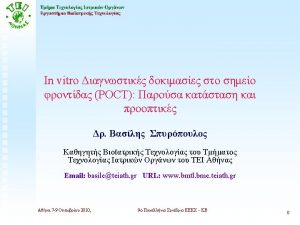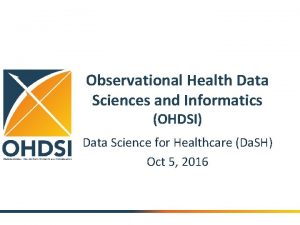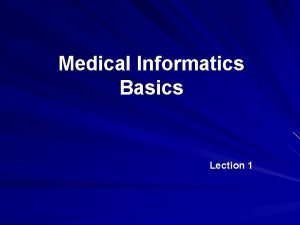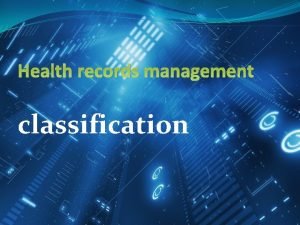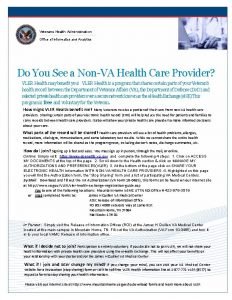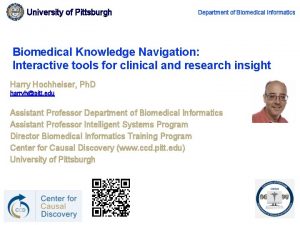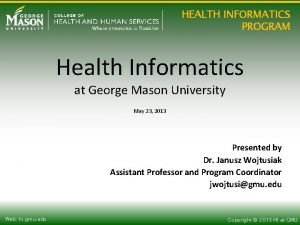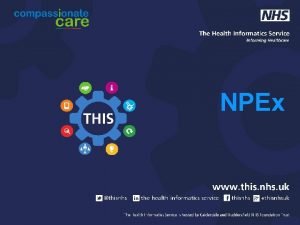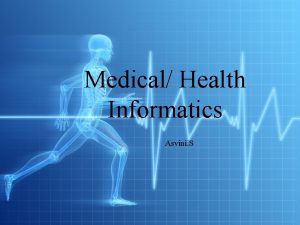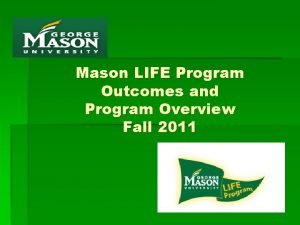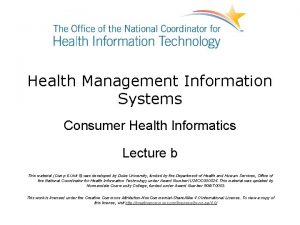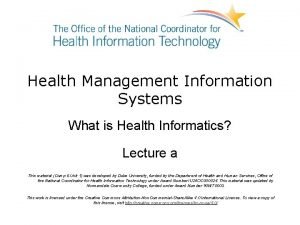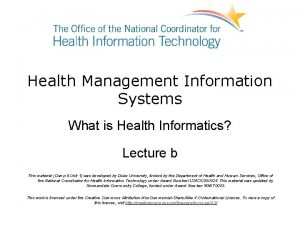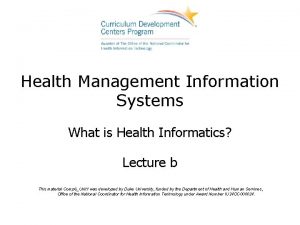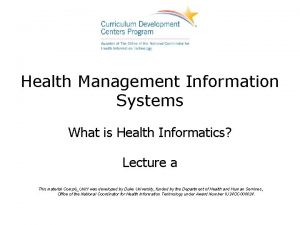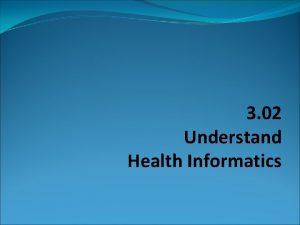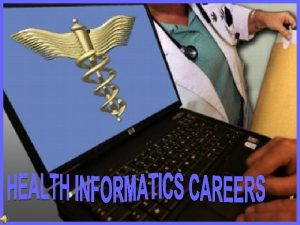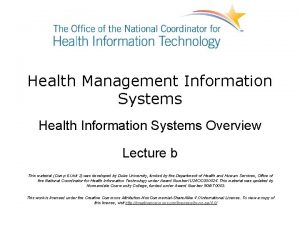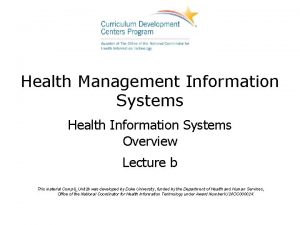Health Management Information Systems Consumer Health Informatics Lecture




















- Slides: 20

Health Management Information Systems Consumer Health Informatics Lecture a This material (Comp 6 Unit 8) was developed by Duke University, funded by the Department of Health and Human Services, Office of the National Coordinator for Health Information Technology under Award Number IU 24 OC 000024. This material was updated by Normandale Community College, funded under Award Number 90 WT 0003. This work is licensed under the Creative Commons Attribution-Non. Commercial-Share. Alike 4. 0 International License. To view a copy of this license, visit http: //creativecommons. org/licenses/by-nc-sa/4. 0/

Consumer Health Informatics Learning Objectives 1. Explain how current and emerging technologies have impacted and may continue to affect consumer health informatics 2. Describe the role of genomics in consumer health informatics 2

Health Communication “The art and technique of informing, influencing, and motivating individual, institutional, and public audiences about important health issues. The scope of health communication includes disease prevention, health promotion, health care policy, and the business of health care as well as enhancement of the quality of life and health of individuals within the community” (Ratzan, 1994) 3

Consumer Informatics Consumer Health Informatics • Consumer informatics – Management of data and information – Supports consumers – Use of computers and computer technologies • Consumer health informatics – Addresses the needs of the consumer 4

Interactive Health Communication • e-Health • Technology – Internet – Web services – Wireless technology • Tools 5

Interactive Health Communication • Tools – Online communities and support groups – Online health information – Online health self-management tool – Online communication with health care providers – Online access to personal health records 6

Impact on Consumer Health Informatics • New roles and approaches to health management – Partnership: o Consumers and health care providers • New expectations – Access to information when needed 7

Impact of the Internet • • Increase in informed consumers Availability of online PHRs New forms of communication Accessibility of health care products for purchasing 8

Impact of Emerging Technologies • Convergence of media and emergence of the Internet results in a networked communication infrastructure • Facilitates access to health information and health-related support services • Expands the communication choices for health professionals, patients, and consumers 9

Social Media • • Social networks Blogs Forums Wikis Photo/video Podcasts Crowdsourced medical treatment and diagnosis recommendations 10

Potential e-Health Value Propositions • Stakeholder: Consumers (e. g. , patients, informal caregivers, information intermediaries) • Benefits sought from consumer e-Health – Private, 24/7 access to resources – Expanded choice and autonomy – New forms of social support – Possibility of better health – More efficient record management – Lower cost health care services – Avoidance of duplication of services 11

Potential e-Health Value Propositions • Stakeholder: Clinicians • Benefits sought from consumer e-Health: – Greater efficiency – Better communication – More adherent and satisfied patients 12

Potential e-Health Value Propositions • Stakeholder: Health care organizations • Benefits sought from consumer e-Health – More patient self-care and health management – Lower administrative costs – Improved quality and patient outcomes 13

Challenges Presented • Concerns with privacy and security • Risk of liability • Lack of law or legislation governing the boundaries • Lack of payment for engagement • Lack of frequent data updates • Resistance by health care providers 14

Role of Genomics • Supply a piece of the personal health record – Family history o A risk factor for many chronic diseases of public health significance 15

Role of Genomics (Ades, 2009) 16

Consumer Health Informatics Summary – Lecture a • Definitions • Impact of the Internet on consumer health informatics • Effect of current and emerging technologies on consumer health informatics • Role of genomics in consumer health informatics 17

Consumer Health Informatics References – Lecture a References American Health Information Management Association. (2012). Pocket glossary for health information management and technology (3 rd ed. ). Chicago, IL: Author. Centers for Disease Control and Prevention. (2010). Genomics and Health. Retrieved from http: //www. cdc. gov/genomics/public/index. htm Centers for Disease Control and Prevention. (2011, May). CDC Social Media Tools. Retrieved from http: //www. cdc. gov/Social. Media/Tools/ Gibbons, M. C. , Wilson, R. F. , Samal, L, Lehmann, C. U. , Dickersin, K. , Lehmann, H. P. , Aboumatar, H. , Finkelstein, J. , Shelton. E. , Sharma, R. , & Bass, E. B. (2009, October). Impact of consumer health informatics applications. Evidence Report/Technology Assessment No. 188. (Prepared by Johns Hopkins University Evidence-based Practice Center under contract No. HHSA 290 -2007 -10061 -I). AHRQ Publication No. 09(10)-E 019. Rockville, MD. Agency for Healthcare Research and Quality. Retrieved from http: //www. ncbi. nlm. nih. gov/books/NBK 32638/pdf/TOC. pdf Health Resources and Services Administration (HRSA). (2003, October). Telemedicine reimbursement report. (Prepared by the Center for Telemedicine Law under contract No. 02 -HAB-A 215304). Retrieved from http: //www. hrsa. gov/ruralhealth/about/telehealth/reimburse. pdf Kaplan, A. M. & Haenlein, M. (2010). Users of the world unite! The challenges and opportunities of social media. Business Horizons 53(1), 59 -68. National Human Genome Research Institute. (2010). Genetic information nondiscrimination act of 2008. Retrieved from http: //www. genome. gov/10002328 Office of Disease Prevention and Health Promotion (ODPHP). (2012). e-Health. Retrieved from http: //www. health. gov/communication/ehealth/Default. asp 18

Consumer Health Informatics References – Lecture a References Ratzan, S. C. (Ed. ). (1994). Health communication, challenges for the 21 st century. Special issue. American Behavioral Scientist 38(2), 202 -207. Robinson, T. N. ; Patrick, K. ; Eng, T. R. ; & Gustafson, D, for the Science Panel on Interactive Communication and Health. (1998, October). An evidence-based approach to interactive health communication: A challenge to medicine in the Information Age. Journal of the American Medical Association, 280(14), 1264 -1269. Valdez R. , Yoon, P. W. , Qureshi, N. , Green, R. F. , & Khoury, M. J. (2010, April). Family history in public health practice: A genomic tool for disease prevention and health promotion. Annual Review of Public Health 31, 69 -87. U. S. Department of Health and Human Services. (2000). Healthy people 2010: Objectives for improving health. Retrieved from http: //www. healthypeople. gov/2010/Document/tableofcontents. htm#volume 1 U. S. Department of Health and Human Services. (2006, June). Expanding the reach and impact of consumer e-Health tools. Retrieved from http: //www. health. gov/communication/ehealthtools/pdf/ehealthreport. pdf U. S. Department of Health and Human Services. (2012). Genomics. Retrieved from http: //www. healthypeople. gov/2020/topicsobjectives 2020/overview. aspx? topicid=15 Image Slide 16: Ades, J. (2009, May 1). Prescription form with DNA double helix. [image on the Internet]. Retrieved from http: //www. genome. gov/press. Display. cfm? photo. ID=20158 19

Consumer Health Informatics Lecture a This material was developed by Duke University, funded by the Department of Health and Human Services, Office of the National Coordinator for Health Information Technology under Award Number IU 24 OC 000024. This material was updated by Normandale Community College, funded under Award Number 90 WT 0003. 20
 Primary secondary tertiary food chain
Primary secondary tertiary food chain Healthmis.ng
Healthmis.ng Poc informatics
Poc informatics Python for informatics
Python for informatics Python for informatics
Python for informatics Python for informatics
Python for informatics Banaprint
Banaprint 01:640:244 lecture notes - lecture 15: plat, idah, farad
01:640:244 lecture notes - lecture 15: plat, idah, farad Observational health data sciences and informatics
Observational health data sciences and informatics Health informatics questions
Health informatics questions Health informatics
Health informatics Chapter 2 career skills in health informatics
Chapter 2 career skills in health informatics Va office of health informatics
Va office of health informatics Pitt health informatics
Pitt health informatics George mason mha
George mason mha Health informatics courses uk
Health informatics courses uk Health informatics career framework
Health informatics career framework The health informatics service
The health informatics service Health informatics ryerson
Health informatics ryerson Masonlife
Masonlife Health informatics in saudi arabia
Health informatics in saudi arabia


